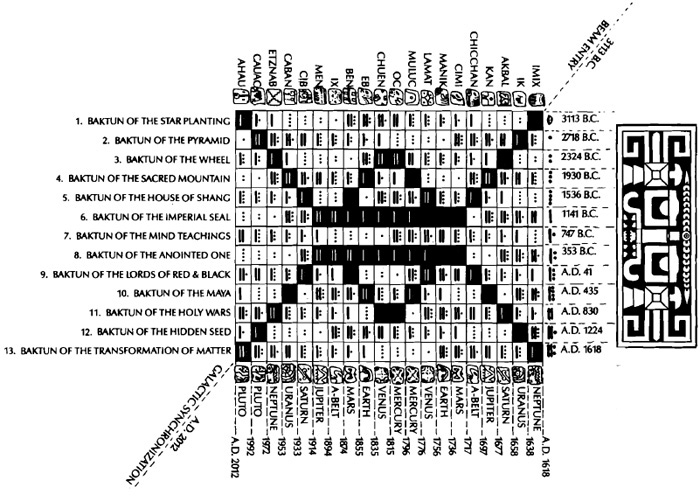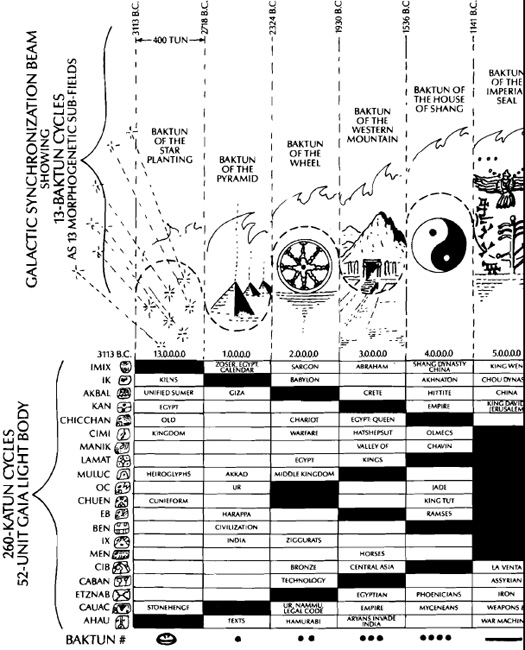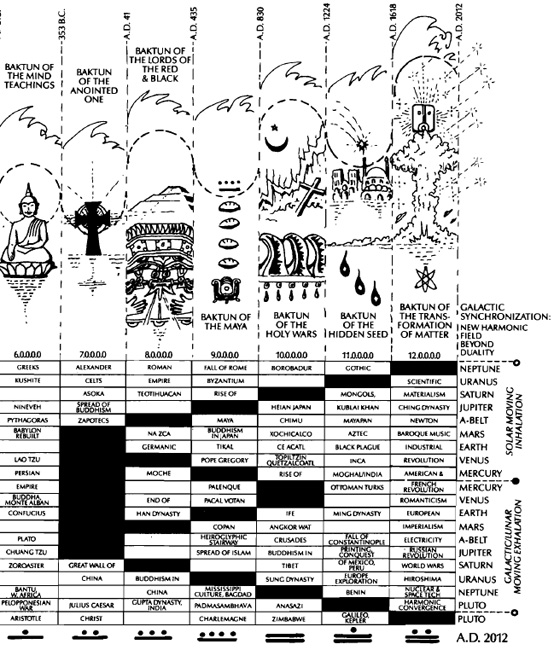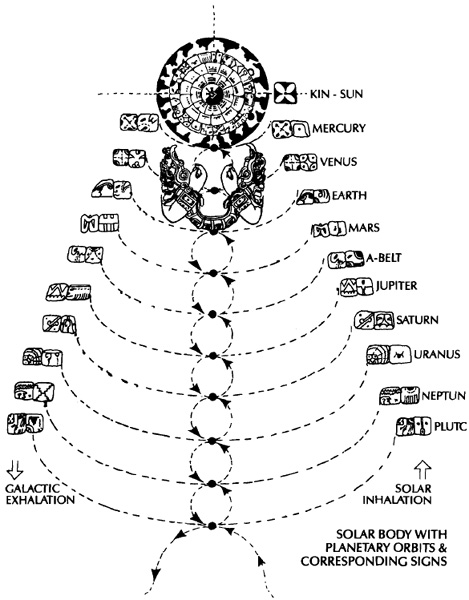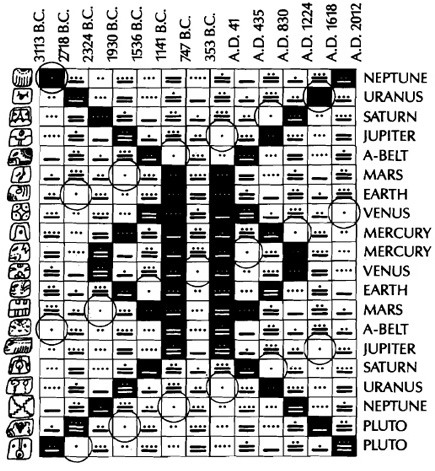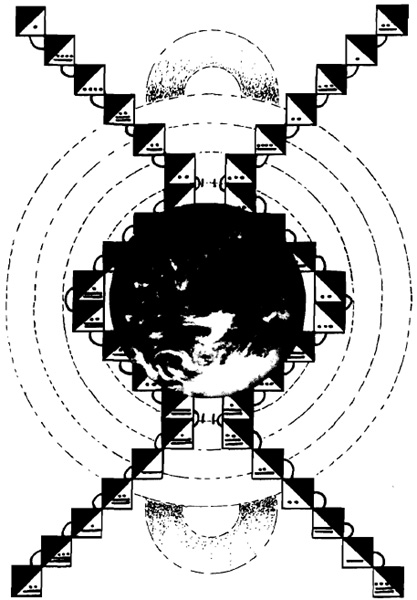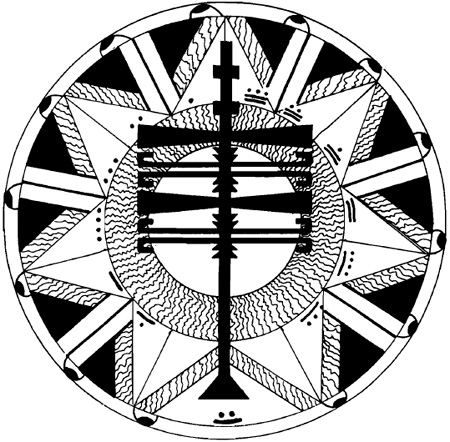 HISTORY & THE SOLAR SYSTEM: THE GALACTIC VIEW
HISTORY & THE SOLAR SYSTEM: THE GALACTIC VIEW
The Mayan Matrix, the Tzolkin or Harmonic Module, bearing the code of the galactic harmonic, informs all systems with a common regulatory resonance called the light body. Just as each living organism possesses a light body—the DNA infrastructure—and even the entire species has its common collective light body, so the planet, as a conscious organism, is also characterized by its evolving light body.
Like the light body of individual and collective organisms, the planetary light body is the consciously articulated resonant structure that regulates and allows for the fulfillment of evolutionary destiny. It is important to bear in mind that the planetary light body, embedded in the planet memory program, can only be activated by conscious, cooperative effort. As we shall see, the key to the conscious articulation of the planet light body is in the science generically known as geomancy—Earth acupuncture.
As the radiant information bank of the planetary program, the 260-unit galactic code can be envisioned as primordially imprinting the electromagnetic ether of the outer planetary sheath, the upper of the two radiation belts that girdle the Earth. I say primordially, because the galactic core, Hunab Ku, like a powerful radio station, is endlessly generating the radiant light code.
The information flow between a planet body like Earth and the galactic core is maintained and mediated by the solar activity known as the binary sunspots. Both Sun and planet operate with the same galactic information bank. Whenever a stellar body, such as our Sun, begins its evolutionary course, it is imprinted with the 260-unit galactic code. Once a planet such as ours attains a point of resonant activation, the galactic information flow mediated through the sunspots imprints the outer electromagnetic sheath with the basics of the planetary memory program.
Once the planetary light program has imprinted and begun its functioning. the genetic information will also be imprinted in the planetary field. On our planet, the genetic imprinting is the function of the lower radiation belt, which can then be envisioned as impregnated by the light program of the upper radiation belt. The two radiation belts are like a vibratory loom, weaving resonance rather than cloth. The common resonance of the lower genetic and the upper galactic imprinting creates the total planet memory program, called the Psi Bank.
Functioning within the interactive membrane of the radiation belts, the Psi Bank engenders what Rupert Sheldrake calls morphogenetic fields—the memory-saturated resonant sub-fields whose functioning accounts for the continuity of the various organic life-forms.
What we are describing here is the intelligence structure of the planet considered as a living organism. In so doing, we are embroidering on James Lovelock's Gaia hypothesis, the notion that the Earth is indeed a conscious, evolving entity. Of course, virtually all prehistoric, that is to say, pre-technological peoples are/were aware of this fact. Through much of history, the belief that the Earth is sacred has commonly been held by peoples everywhere.
While we can say that the sacredness of the Earth as a living organism has long been a commonly held belief, it is another question altogether whether or not' all people holding this belief shared their knowledge collectively or had as complete a view of the Earth as we possess today, thanks to our cumbersome but unifying space technology. Leaving aside arguments which declare that a common science was shared by the builders of Stonehenge, the Great Pyramid at Giza, and the Pyramids of Teotihuacan, let us assert, at the least, that by virtue of common resonance there was some such "universal" knowledge.
Given this perspective, let us introduce the Mayan Harmonic in its form as the Great Cycle—the Galactic Synchronization Beam. Let us go back some 5,000 years and describe a twofold situation. On the one hand is the situation of the Earth. On the other is the situation of the galactic navigators called Maya. First, let us discuss the Earth.
Following the last Ice Age over 12,000 years ago, a new cycle of life, a new solar age, began for the planet. Here and there we find remnants of an earlier cycle. This especially seems to be the case in South America. These out posts of earlier cycles remain hidden, discreet, watchful but uninvolved in the new cycle. Within 6,000 years, agricultural experiments begin to yield results in the river vallies of India, the Middle East, and North Africa. Galactic information infused through the Sun impregnates the mental fields of the agricultural peoples. Dim recollections of earlier cycles, other times, other planes of existence mingle with veneration of the Sun. A ripeness of thought and feeling builds up. Another cycle of civilization is about to commence.
At the same time, among the starry outposts of the Maya, none of what is occurring on planet Earth goes unnoticed. The word is out: another planet is gearing up for activation of its light body. Through collective effort of the larger community of galactic intelligence, the galactic synchronization beam is focussed through the Sun and its planetary system with special attention to the third planetary orbit, that of Earth. At just the right moment, through a collective mental intensity unheard of on our planet, the beam, 5,200 tun in diameter is activated; the Great Cycle commences.
Scholars quibble about the exact date that the Mayan Great Cycle began. Some say August 13, others August 11, yet others August 6, 3113 B.C. Of course, the date August 6 is interesting because it is the date the Chinese commemorated as the midpoint between the summer solstice and the autumn equinox. It is also the acknowledged date of the atomic bombing of Hiroshima. In any case, it is almost exactly 5,100 years ago that the planet entered the galactic synchronization beam. It is only some 26 years from this writing that the planet leaves the beam.
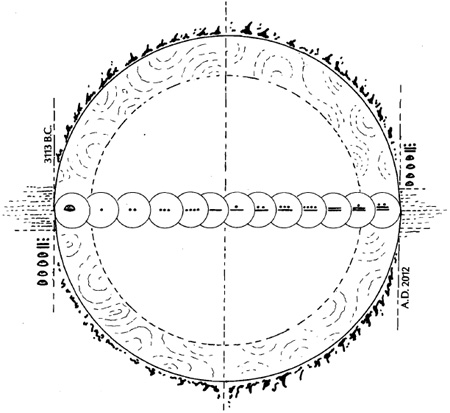
13-BAKTUN BEAM PASSAGE OF PLANET EARTH
But what is this beam? How do we describe it? What does it synchronize and how? In Mayan terms, this beam, the Great Cycle, measures 5,200 tun in diameter. In terms of kin or days, a tun consists of 360 kin/days each, or five days short of a vague solar year. An actual solar year is 365.2422 days. Thus 5,200 tun equals 5,125 vague solar years or 1,872,000 days.
As we have emphasized, the Mayan concern was with calibrating an equivalence between the calendar marking Earth's solar passage and the actual galactic harmonic. The 5,200-tun cycle represents a fractal of the 52-unit key, the Loom of Maya, synthesizing the galactic harmonic. As a fractal, the 5,200-tun cycle can be broken into 260 units of 20 tun each called katuns, and 13 units of 400 tun each called baktuns. While the key harmonic number of a tun is 360 kin and the katun is 7,200 kin, the baktun is 144,000 kin. It is very important to keep in mind that Mayan numbers are multi-dimensional. Their translation into days or years does not mean that the numbers cease being operational for other factors or values. The cycle of history as a 5,200-tun diameter harmonic wave-pattern is but one slice of a multi-dimensional galactic hologram.
As we also noted, when a schematic of the Great Cycle is presented as a set of thirteen baktuns arranged into twenty katuns each, thus creating the 260-unit grid, it is indistinguishable from the grid representing the 260-day Sacred Calendar, or Tzolkin. In other words, the Tzolkin and the Great Cycle are fractals of each other. But then, both being fractals of the 260-unit galactic harmonic, how else could it be?
Thus, in the schematic, The Mayan Harmonic Module as the Great Cycle, the vertical columns starting on the lefthand side represent the sequence of thirteen baktuns. Counting down from the top left, each column possesses twenty informational units, each unit representing a katun cycle. Since the count of informational units 1-13 also proceeds in unbroken sequence from the top left down, a further breakdown of cycles can be presented, that of twenty cycles of thirteen katuns, each of these cycles being represented by the number sequence 1-13. Thus, there are thirteen baktuns of twenty units each, and twenty subcycles of thirteen katuns each. The Maya called this overlay of twenty thirteen-katun subcycles Ahau cycles.
Summarizing then, the Great Cycle consists of: 1,872,000 kin/days; 5200 tun of 360 kin/days each (slightly less than one year per tun); 260 katun of 7200 kin/days each (slightly less than twenty years per katun); twenty Ahau cycles of thirteen katuns or 93,600 days each (260 tun or approx 256 years per Ahau cycle); thirteen baktun of 144,000 kin/days each (400 tun or slightly more than 394 years per baktun).,
The key unit to look at is the baktun cycle. Remembering that the tun is short five days of a vague solar year, then the formula, 400 tun = 20 katun = 1 baktun, rounds out to slightly more than 394 vague solar years. In other words, in its subdivision into thirteen baktun cycles, the Great Cycle or Galactic Synchronization Beam repeats the key galactic number sequence 1-13. With this set of thirteen baktuns represented by the thirteen vertical columns of the Mayan Harmonic Module, we can begin to construct the calendar of the Great Cycle, overlaying it on the time period 3113 B.C.-A.D. 2012.
First, let us list the thirteen baktun cycles in sequence. It should be noted that the first cycle is baktun 0, the second is baktun 1, etc., meaning that a cycle is not counted until its duration has elapsed one round. In contemplating each of the baktun cycles as represented on the module, attention should be paid to the Loom of Maya units occurring in each cycle. These Loom of Maya units, of which there are 52, represent periods of more intensified galactic activation. The names given to the 13 baktun cycles refer to the key event/qualities distinguishing that cycle.
MAYAN HARMONIC MODULE AS THE GREAT CYCLE
1. Baktun 0 (=13). Baktun of the Star Planting. 3113-2718 B.C. 13.0.0.0.0
Entry of Earth into Galactic Synchronization Beam. Planting of "star-transmissions" of the galactic league among peoples across the planet. Consolidation of upper and lower Egypt 3100B.C. Expansion of Sumeria, 3000 B.C. Construction of Stonehenge begun, 2800 B.C.
2. Baktun 1. Baktun of the Pyramid. 2718-2324 B.C. 1.0.0.0.0
Construction/activation of Great Pyramid at Giza, Egypt, 2700-2600 B.C., marks anchoring of planet light body. Spread of Sumerian civilization, Akkad and Ur, and development of bronze. Beginning of Harappa, Indus civilization. Beginning of settled agricultural life, China, Mesoamerica, Andes.
3. Baktun 2. Baktun of the Wheel. 2324-1930 B.C. 2.0.0.0.0
Full establishment of wheel, initiation of transport technology and cyclical thought, written codes of law, and metallurgical technology in Mesopotamia. Sargon and first Babylonian empire. Beginnings of chariot warfare, territorial imperialism. Era of legendary emperors, China. Establishment of Minoan civilization, Crete.
4. Baktun 3. Baktun of the Sacred Mountain. 1930-1536 B.C. 3.0.0.0.0
Middle and New Kingdom in Egypt; relocation of center to Sacred Mountain of the West, Valley of the Kings, marks decision of Egyptians to perpetuate dynastic rule, consolidates pattern of defensive territorialism as norm for civilized life. Waves of invaders—Hittites, Aryans; destruction of Minoan, Indus civilizations.
5. Baktun 4. Baktun of the House of Shang. 1536-1141 B.C. 4.0.0.0.0
Establishment of Shang Dynasty, China, enunciation of yin/yang doctrine, advanced bronze metallurgy and pattern of Chinese civilization. Beginnings of Vedic civilization, India. Emergence of Chavin civilization, Andes, and Olmecs, Mesoamerica. Akhenaton, Egypt; Abraham and Moses, Israel; Hittite consolidation, Mesopotamia.
6. Baktun 5. Baktun of the Imperial Seal. 1141-747 B.C. 5.0.0.0.0
Babylonian-Assyrian empires. Iron weaponry and war machines. Rise of Mycenean Greeks in Mediterranean, sack of Troy. Chou Dynasty, China, emergence of I Ching. Spread of Olmec culture throughout Mesoamerica. Horse used for warfare, pattern of militaristic imperial rule and dynastic succession established as norm for civilized life on planet.
7. Baktun 6. Baktun of the Mind Teachings. 747-353 B.C. 6.0.0.0.0
Period of first wave of galactic Mayans in Mesoamerica. Persian Empire. Rise of philosophical individualistic thought supplanting earlier collective forms. Pythagoras, Socrates, Plato, Aristotle in Greece; six schools of Vedic thought, Mahavira and Buddha, India; Lao Tzu, Confucius, Chuang Tzu in China. Construction of Monte Alban, Mexico, beginnings of Mayan calendar systems.
8. Baktun 7. Baktun of the Anointed One. 353 B.C.-A.D. 41. 7.0.0.0.0
Hellenistic civilization, Alexander the Great; Rise of Rome, beginning of Roman Empire; Celts in Europe, advanced iron technology; Warring States' consolidation of China by Ch'in Huang Ti, beginnings of Han Dynasty, Great Wall of China; spread of Buddhism as cosmopolitan religion from India to Central Asia. Jesus Christ, gnostic religions of Middle East; diffusion of Olmecs and beginning of Teotihuacan.
9. Baktun 8. Baktun of the Lords of the Red and Black. A.D. 41-435 8.0.0.0.0
Completion of Pyramid Center of Teotihuacan, consolidation of Mesoamerican cultural regime, Lords of Red and Black, first teachings of Quetzalcoatl; Moche, Nazca, and Tiahuanaco in Andes; Easter Island; emergence of West African kingdoms; expansion and collapse of Roman Empire, rise of Christianity; collapse of Han Dynasty, spread of Buddhism in China, Southeast Asia.
10. Baktun 9. Baktun of the Maya. A.D. 435-830. 9.0.0.0.0
Second galactic Mayan visitation, Pacal Votan of Palenque and flourishing of Mayan cultural regime; Muhammed and rise of Islam; Roman Christian Western Europe and Byzantine Orthodox Christian Eastern Europe; rise of Hinduism, India; spread of Buddhism to Tibet, Korea, Japan; T'ang Dynasty, China; rise of kingdoms in Southeast Asia, Indonesia (Borobadur, Java); ascendency of Tiahuanaco, Andes; Polynesian civilization, Oceania; early flourishing of Nigerian civilization.
11. Baktun 10. Baktun of the Holy Wars. A.D. 830-1224 . 10.0.0.0.0
Collapse of Classic Maya and Central Mexican civilization, 1 Reed Quetzalcoatl and rise of Toltecs; Chan Chan and Chimu civilization Andes; rise of l'fe in Nigeria; flourishing and spread of Islam and confrontation with Christian civilization—the Crusades; rise of Tibetan civilization; Sung Dynasty, China, printing press, gunpowder; Khmer Dynasty, Southeast Asia. Great Zimbabwe, East Africa.
12. Baktun 11. Baktun of the Hidden Seed. A.D. 1224-1618. 11.0.0.0.0
Expansion of Islam to India, Central and Southeast Asia, West Africa; seclusion of Tibet; rise of Turks, Mongols, conquest of China; seclusion of Japan; rise of Zimbabwe, East Africa, l'fe and Benin, West Africa; peak of Christian civilization, West Europe, and rise of Orthodox Russian civilization, East Europe; Reformation and split of Christian Church; spread and triumph of European civilization in conquest of Inca and Aztec empires; beginning of European colonization, decline of sacred world view (hidden seed).
13. Baktun 12. Baktun of the Transformation of Matter. A.D. 1618-2012. 12.0.0.0.0
Rise and triumph of scientific materialism, European world conquest; Industrial Revolution, Democratic revolutions of America, Europe; colonialism of Africa, Latin America, Asia; industrialization of Japan; Karl Marx and rise of communism; communist revolutions of Russia, China; World Wars I and II; atomic bomb and nuclear era; rise of Third World powers, Islam, Mexico ,and India; global terrorism and collapse of technological civilization; Earth purification and final era of global regeneration; information age and crystal solar technology; galactic synchronization.
13-BAKTUN CYCWAVE-HARMONIC OF HISTORY
What we witness in this summary review of the character and chief activity of the thirteen baktun cycles is an acceleration and expansion of activity, building up in a great wave formation reaching its climax in the thirteenth cycle, Baktun 12, the Baktun of the Transformation of Matter. The name of the final baktun, as well as of the initial one, the Baktun of the Star Planting, gives the clues. What appears as a process of history—the Great Cycle—is actually a planetary process, a stage in the conscious growth of Earth, the crafting of Earth's light body.
In this total planetary endeavor, humans are the sensitive atmospheric instruments galactically utilized in a process whose objective is the transformation of the "material field" of the planet. The end of this transformation is to raise the overall planetary field to a higher, more harmonic level of resonant frequency. In this way, the planet light body, the consciously articulated etheric sheath of Earth, is constructed. This is something of what is meant in the reference to the Great Cycle as the 5,125-yeardiameter of a Galactic Synchronization Beam.
In order to grasp the meaning of history as the galactically synchronized construction of the planet light body, it is necessary to understand the role of our planet in relation to the larger organism of which it is a participating member—the solar system. As we understand it, the solar system consists of a central star—the Sun—and its family of at least ten planets. This solar system is a self-contained organism whose subtle sheath or morphic field is called the heliocosm. Every 11.3+ years the heliocosm pulses outward and then for another 11.3+ years it pulses inward. These 11.3 year inhalation-exhalation cycles are referred to as the heliopause whose total movement occurs over a period of some 23 years. While sixteen 260-day cycles equal 11.3 years, 11.3 twenty-three year cycles amount to approximately 260 years.
The registering of the solar inhalation-exhalation by the heliopause corresponds precisely to the activity of the binary sunspot movements. In the sunspot activity, two "spots"—one negative, the other positive—pulse inward from positions 30 degrees north and south toward the solar equator. Approximately every 11.3+ years, the two "spots" meet at the equator, reverse polarity, and begin the process again at 30 degrees north and south of the solar equator. Cued to the heliopause, the total sunspot movement occurs in a period just under 23 years. In other words, the morphic field of the Sun has a breathing pattern some 23 years in duration.
Clearly, the sunspots, whose activity causes great disturbances to Earth's radio waves and the bio-electromagnetic field in general, are connected with the solar breathing process. If we can view the solar system as a colossal organism whose body, the heliocosm, encompasses the orbits of the planets, what is the role of the planets within the solar body, and how does the solar breathing process affect the planets?
In our consideration of these matters, we must also take into account another important variable. If the Earth is a consciously evolving, living organism, what about the Sun about which it orbits? Brief contemplation leads us to the inescapable position that the Sun, too, possesses an intelligence—but one that is vast and virtually incomprehensible to us. Nonetheless, our forebears of the ancient civilizations of Egypt and Mexico, Peru and Mesopotamia had some knowledge of this, and in this knowledge lies their so-called sun worship. Furthermore, the activity of the heliopause and binary sunspots yields some indication of the nature of the solar-intelligence energy process. From the accumulated knowledges, ancient and modem, we may give the following description of the intelligent solar organism.
Coordinated by a central star which continuously monitors galactic information through the cyclical pulsing of its binary receiver/transmitters, the solar body is articulated as a series of subtle waves corresponding to the orbits of the ten planets. As Kepler intuited, the planetary orbits possess a harmonic relation to each other. In this way, the Asteroid Belt was discovered orbiting between Mars and Jupiter, Uranus was discovered orbiting beyond Saturn, and Neptune and Pluto were later discovered orbiting beyond Uranus. What is important in this description of the solar field is the harmonic wave-pattern created by the planetary orbits in their movement around the Sun. What, then, of the planets themselves?
If the Sun is the central coordinating intelligence in the solar field, the planets represent harmonic gyroscopes whose purpose it is to maintain the resonant frequency represented by the orbit which the planet holds. Indeed, this is precisely the description of Earth, for instance, spinning on its axis.
Though the heliocosm, the total solar body, is a self-regulatory system, it is at the same time a subsystem within the larger galactic field. Thus, its inhalation consists of cosmic forces—galactic frequencies—monitored either directly from the galactic core and/or via other intelligent star systems. Its exhalation represents transmuted streams of energy/information returned back to the galactic core, Hunab Ku. The planets, orbital harmonic gyroscopes, assist in the mediation of the energy information f1ow to and from the galactic core. The inhalation represents a solar-moving flow; the exhalation, the lunargalactic flow. As we shall see, there is a correspondence between the solar inhalation-exhalation, the ten planet gyroscopes, and the twenty Sacred Signs.
In the overall solar evolutionary process, which encompasses our own planetary evolution, let us say that the purpose is to arrive at a superior intelligent coordination of the various planetary centers to the central solar core and of the central solar core to the galactic core. The indices of the solar body's attaining new levels of conscious integration are represented by the increasingly harmonic frequencies of the planetary orbits in resonance with the Sun's own increased harmonic frequency.
Let us also assume that in the process of a star's attaining to such a level of conscious, intelligent coordination, it reaches a stage in which cooperation is solicited and received from other, more evolved star systems. The cooperation of the other star systems would be in the form of a resonant frequency synchronization beam focussed on the orbiting harmonic gyroscopes, the planets themselves.
The focussing of such a resonant frequency synchronization beam would naturally be attuned to the galactic harmonic and would represent a minimum fractal of the total galactic seasonal flow. As we have already seen, this galactic harmonic is 5,200 tun or 260 katun in diameter and contains and encompasses all the mathematical ratios governing the radiant and genetic properties of universal life. For reasons which will become more evident as this vision of solar intelligence and galactic community unfolds, the focussing of this beam, corresponding to Earth time, 3113 B.C.-A.D. 2012, has been of particular significance for the transformation of terrestrial intelligence. let us just say for the moment that during this synchronized 5,200-tun beam, the resonant harmonics of the third orbital gyroscope, Earth, have been deemed pivotal in the establishment of a stage of intelligent coordination, allowing the solar system to enter fully into the community of galactic intelligence.
Within the context of morphogenetic fields, the 5,200-tun Great Cycle can be viewed as a galactically activated field of a purposeful resonance divided into thirteen cyclical subfields. As a total field of resonance, the purpose of the Great Cycle is to facilitate Earth's lift-off—the creation and realization of the planetary light body. Through human instrumentation resulting in the transformation of matter and the simultaneous creation of a species-transcending coordination of intelligence, a genuine planetary consciousness is attained. This acquisition of planetary intelligence, represented by the sign MEN, is the prerequisite for attaining conscious resonance with the central solar intelligence, represented by the sign AHAU.
To make all of this information more meaningful and useful, let us return to the thirteen baktun cycles as the wave-harmonic of history. let us look at these thirteen cycles as a landscape of morphic resonance divided into seven mountains and six valleys. Each a discrete field of morphic resonance unto itself, these seven mountains and six valleys build up as a single, ever-gathering wave-formation to a climax which occurs toward the end of the thirteenth cycle. The purpose of this "climax of matter" towards the end of the thirteenth cycle, the Baktun of the Transformation of Matter, is to induce an increase in harmonic frequency. Remembering that the Earth is a harmonic gyroscope, this heightened harmonic resonance affected by a singular unification of human consciousness will assist, sooner than later, in the propelling of the solar body into the community of galactic intelligence.
In this consideration of the thirteen baktun cycles of the synchronization beam considered as thirteen morphic subfields, our attention is drawn to the ending and beginning of the cycles themselves. The points of transition between the subcycles are critical in our understanding of morphogenetic fields. For while the field holds the memory for a species, it is at moments of cyclical transition that changes in the programming are introduced. Obviously the more minute the cycle, the subtler the program change; the larger the cycle, the greater the program change. In the human organism, these changes are experienced as shifts in the dominance of particular archetypal patterns.
SOLAR BODY WITH PLANETARY ORBITS & CORRESPONDING SIGNS
Thus, each baktun cycle possesses a particular morphic resonance, represented by a particular archetype or set of archetypal symbols. In this regard, symbols can be considered as resonant capacitators. That is, a symbol, properly constructed, contains the capacity to evoke a particular resonance no matter where or when. In this way particular archetypal resonances set in motion during one baktun may carry over into another, or several others. This situation is made more complex, given the human tendency to distort according to egotistic or territorial imperatives.
Representing a discrete field of morphic resonance, the baktun accounts for cyclic change. A cyclic transition describes the point at which one cycle ends and another begins. Every 394 years in the morphogenetic subfield called baktun, there is a pause or a break. During this break or cyclical pause, certain symbolic modes or cognitive dispositions are discarded and a certain new Psi Bank imprinting occurs. Naturally, there are lesser cycles in which this occurs, particularly the "generational" katun cycles of 19+ years. But the significance of the baktun cycles lies in their vastness in relation to the duration of a single human existence.
Thus, as we look over the map of the Galactic Synchronization Beam landscape, we see building up over 5,125 years the series of thirteen morphogenetic fields in their archetypal character, each subdivided into twenty katun subcycles. Though the transitions between the fields are not always marked by anything obviously momentous, we may nonetheless distinguish in each of the subfields, an overall marked change of character. As indicated, these changes of character are due to the generally unconscious discarding of certain symbolic/cognitive features and the imprinting of new information, the sum of which comprises the quality of the new morphic subfield. Thus, a transition between cycles marks an information transfer and imprint that affects and seals the overall memory bearing quality of the new morphogenetic field.
Cyclical change is important, because it is the means by which creativity is introduced at a species/planet-wide level. Any change in a morphic field is preceded by a morphogenetic subduction prior to the transition. A subduction is a sudden pulling down of energy that precedes a somewhat later upheaval or discharge of new energy in the new morphic subfield. This subduction is usually occasioned by an event which presages what is to come. Thus, the construction of Stonehenge, with all of its astronomical and geodetic proportions could be viewed as the subduction event concluding the initial baktun of the Star Planting and presaging the following baktun, that of the Pyramid.
In any case, what is genuinely significant for us now is the subduction prior to the conclusion of the total cycle. If the changes between baktuns can be considered momentous, then the subduction and change occasioned by the conclusion of the entire Great Cycle must be of unprecedented proportions. This change, which has already been initiated, is signaled by a resonant frequency shift which will herald the conclusion of the Great Cycle or 5,200-tun Galactic Synchronization Beam, and will presage the brilliance of the post-A.D. 2012 phase of our galactic/solar/planetary reality.
In this general description of the thirteen subcycles of the Great Cycle or 5,200tun Galactic Synchronization Beam, the patterns of human history become not only morphic resonances of a total planetary evolutionary process, but the planet itself plays its role in the larger morphogenetic harmonic of the solar system. Though, from a certain perspective, the human element is but the instrument of galactic purposes, this instrumentation is of necessity intelligent and purposeful. And if, at this stage in the harmonic calibrations of the Great Cycle, we are at the point of climax and the painful shedding of much that we have developed to get to where we are, the unconscious construction of our labors finally looms into view: the Light Body of Planet Earth—the raiment of Gaia, worn like a radiant garment from pole to magnetic pole.
Having sketched out the general morphic landscape of the thirteen baktuns of the Great Cycle, we may now turn to a consideration of the katun cycles. There are twenty katuns of something less than twenty years each to every baktun cycle. The significance or meaning of the katun cycles is derived from the symbolic attributes of the glyph associated with the katun. Thus, the first katun cycle is always associated with the glyph IMIX, the last with the glyph AHAU. The entire sequence of glyphs, then, gives a symbolic profile of the general unfolding of the morphogenetic pattern of any given baktun. The meaning of the katun cycles is further modified by the number accorded to the particular cycle.
The twenty-katun cycle, giving the general structure of the organic pattern of the baktun, may be constructed in the following manner:
- IMIX: Katun 0. Morphogenetic Pattern Set
- IK: Katun 1. Morphogenetic Pattern Receives Inspiration
- AKBAL: Katun 2. Morphogenetic Pattern Receives Consecration
- KAN: Katun 3. Morphogenetic Pattern Seeded into Daily Life Patterns
- CHICCHAN: Katun 4. Morphogenetic Pattern Becomes Secondary Instinct
- CIMI: Katun 5. Morphogenetic Pattern Provides Base of Revelation
- MANIK: Katun 6. Morphogenetic Pattern Provides New Skill Base
- LAMAT: Katun 7. Morphogenetic Pattern Realized as Cosmic Law
- MULUC: Katun 8. Morphogenetic Pattern Established as Principle of Communication
- OC: Katun 9. Morphogenetic Pattern Established as Social Principle
- CHUEN: Katun 10. Morphogenetic Pattern Emerges as Dominant Artistic Force and Vision
- EB: Katun 11. Morphogenetic Pattern Experienced as Inescapable Human Nature
- BEN: Katun 12. Full Maturation of Cyclic Morphogenetic Pattern
- IX: Katun 13. Beginning of Transcendence of Existing Pattern
- MEN: Katun 14. Higher Aspects of Morphogenetic Pattern Pervade Total Educational Field of Cycle
- CIB: Katun 15. Galactic Impulse toward New Cycle Begins to Be Felt
- CABAN: Katun 16. Morphogenetic Pattern Reaches Climax of Power
- ETZNAB: Katun 17. Morphogenetic Pattern Shows Self-Imitative, Self-Destructive Aspects
- CAUAC: Katun 18. Morphogenetic Pattern Begins Transformation
- AHAU: Katun 19. Morphogenetic Pattern Completes Transformation
Given this information of the thirteen baktuns and their twenty katun cycles, the 260-unit frame of the abacus of history may be constructed and contemplated. In addition to the symbolic glyph signs accorded to each of the katun cycles, there is also the harmonic number overlay—the twenty AHAU cycles showing the sequence of the numbers 1-13. Called by the post-classic Maya the AHAU Cycles, these twenty cycles, each thirteen katuns in length, provide a second harmonic galactic synchronization wave-pattern overlay, each 2S6 years in length. While the longer 400-tun baktun cycles bear the morphogenetic imprinting relating to the interaction of human and planetary consciousness, the shorter AHAU cycles, being 260 tun in duration—the number of the galactic code—represent higher galactic imprinting. This galactic imprinting is what infuses the total pattern of the Great Cycle/Galactic Synchronization Beam with the galactic momentum—the drive toward the resonantly transformative conclusion of the total cycle in A.D. 2012.
Thus, while the thirteen-baktun cycles may be envisioned as a gathering wave of seven mountains and six valleys, the twenty AHAU cycles may be imagined as the spiral of planetary DNA turning twenty times in a direction running parallel to and interacting with the baktun cycles but from a source above the baktun wave form. In addition to bearing their own discrete galacto-morphic quality, the AHAU cycles also account for the carryovers of morphogenetic information from one baktun to the next. In our rendering of these twenty thirteen-katun AHAU cycles, the name of the cycle is derived from the glyph to which the number 1 is affixed, initiating the cycle. In addition, a weave of mytho-poetic descriptions is woven describing the single, larger movement of the planet light body, the mind of the Earth, over the course of the 5,125-year Great Cycle.
- l IMIX: 3113-2857 B.C. The Seed Is Nurtured
- 1 IX: 2857-2601 B.C. Guarded by the Magicians
- 1 MANIK: 2601-2344 B.C. Given to the Builders
- 1 AHAU: 2344-2087 B.C. Offered to the Sun
- 1 BEN: 2087-1830 B.C. Watched by the Sky-Walkers
- 1 CIMI: 1830-1574 B.C. Concealed in Death
- 1 CAUAC: 1574-1318 B.C. Ripened by the Storm
- 1 EB: 1318-1062 B.C. Which Enters the Human
- 1 CHICCHAN: 1062-806 B.C. Eaten by the Serpent
- 1 ETZNAB: 806-550 B.C. Ritualized by the Sword
- 1 CHUEN: 550-294 B.C. Mastered by the Trickster
- 1 KAN: 294-38 B.C. To Be Sown Again as Seed
- 1 CABAN: 38 B.C.-A.D. 219. Of the Force of the Earth
- 1 OC: A.D. 219-465. By Loyalty Guided
- 1 AKBAL: A.D. 465-731. Through the House of the Night
- 1 CIB: A.D. 731-987. Illumined by the Cosmic Force
- 1 MULUC: A.D. 987-1243. To Return through the Cosmic Gate
- 1 IK: A.D. 1243-1499. As Spirit Pure
- 1 MEN: A.D. 1499-1755. To Gather Whole the Mind of the Earth
- 1 LAMAT: A.D. 1755-2012. And Seal It with the Star-Seed Harmony
 = BEGINNINGS OF 20 AHAU CYCLES
= BEGINNINGS OF 20 AHAU CYCLES
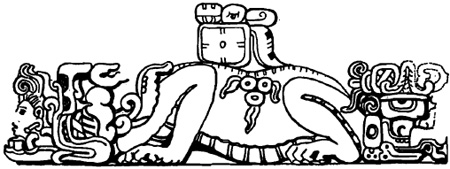
20-AHAU CYCLE OVERLAY
Here the entire movement of the current cycle of history and civilization is seen as a unified movement, a wave harmonic, whose mythic end is in the conscious radiance of the Earth harmonized with the galactic force.
Contemplating the overlay of the twenty thirteen-katun cycles upon the thirteen baktuns comprising the two interactive fields of the 5,125-year diameter Galactic Synchronization Beam, a richness of meaning emerges. As the symbolic calculus of history, the bead game, the abacus of time, the Mayan Harmonic Module reveals a pattern or sets of patterns as mathematically precise as they are poetic. It is a pattern in which the human is integrally interwoven—not as the supreme ruler of a planet whose right it is to exploit, but as a mythic agent molded as much by galactic and terrestrial forces as by the karmic web that we have woven of our own collective actions.
As we shall see, adding to these overlays of katun cycles, numbers, symbolic associations, wave-patterns and historic fact, there are other planetary—harmonic gyroscopic—associations that also affect the meaning of each katun cycle. But for the moment, let these preliminary associations suffice. The point here is that we are given a view of the cycle of civilization matrixed according to the galactic code, the governing code of the light body. This light body, the vibratory infrastructure imprinted by the 260-unit galactic code, operates at all levels, whether that of a planet, a species, or an individual organism. In the development of a planet within a larger star system, it is of great significance, however, when this light body attains to a level of conscious radiance. This, of course, is the underlying purpose of the 5,125-year-diameter galactic synchronization beam that has now almost completely passed through our planet.
With this in mind, let us turn our attention to the construction of the planet light body. The vital form of the planet light body is the structure created by the 52-katun periods corresponding to the 52-unit resonant Loom of Maya. It is these 52-katun periods that are of particular importance in the galactic synchronization process. It is during these 52-katun cycles that the galactic force, though barely perceptible to everyday consciousness, is intensified with qualities that accord with the number and nature of the symbol accorded to that particular katun cycle, i.e., 12 CABAN, 7 IMIX, etc.
In presenting the 52-katun cycles, we are aware of the complete symmetry pattern constituted by the loom of Maya and the Harmonic Module. Not only do we find that the mirror numbers are reflected in the cycles, i.e., cycle 1 and cycle 13, cycle 2 and cycle 12, etc., but that there is an inverse correspondence or counterpoint operative as well. This means that the first light-body katun unit corresponds to the last; the second to the second-to-the-last, etc. It is as if invisible webs connect the most distant points of the cycle, the one weaving forward from the beginning, the other weaving backward from the end. But then, that is as it should be, for a cycle or a circle is harmonic throughout, any given point has a symmetrical correspondence elsewhere in the cycle/circle. What is generated at one point is completed at a symmetrical other point. And in the whole, who is to separate the cause from the effect? Where we begin is where we end, and rather than there being anything like what we imagine evolution to be, there is only essence—there may be digressions from essence, and returnings to essence, but finally there is only essence.
Given this perspective, let us present here the 52-unit light body of history as a set of 26 Galactic Synchronization Beam correspondences:
CYCLE 1, Baktun 0
1. 1 IMIX: 3113-3103 B.C.
2. 7 AHAU: 2737-2718 B.C.
CYCLE 2, Baktun 1
3. 9 IK: 2698-2678 B.C.
4. 13 CAUAC: 2363-2344 B.C.
CYCLE 3, Baktun 2
5.4 AKBAL: 2285-2265 B.C.
6. 11 OC: 2146-2127 B.C.
7. 12 CHUEN: 2127-2107 B.C.
8. 6 ETZNAB: 1989-1970 B.C.
CYCLE 4, Batkun 3
9. 12 KAN: 1871-1852 B.C.
10.4 MULUC: 1774-1754 B.C.
11. 7 OC: 1715-1695 B.C.
12. 12 CABAN: 1615-1595 B.C.
CYCLE 5, Baktun 4
13.7 CHICCHAN: 1457-1438 B.C.
14. 10 LAMAT: 1398-1379 B.C.
15. 2 BEN: 1300-1281 B.C.
16. 5 CIB: 1242 -1222 B.C.
17. 2 CIMI: 1042-1022 B.C.
18. 3 MANIK: 1022-1002 B.C.
19. 4 LAMAT: 1002-983 B.C.
20. 5 MULUC: 983-963 B.C.
21. 6 OC: 963-943- B.C.
22. 7 CHUEN: 943-923 B.C.
23. 8 EB: 923-904 B.C.
24. 9 BEN: 904-884 B.C.
25. 10 IX: 884-844 B.C.
26. 11 MEN: 844-824 B.C.
CYCLE 8, Baktun 7
36. 12 MEN: 80-60 B.C.
35. 11 IX: 100-80 B.C.
34. 10 BEN: 119-100 B.C.
33. 9 EB: 139-119 B.C.
32. 8 CHUEN: 159-139 B.C.
31. 7 OC: 178-159 B.C.
30. 6 MULUC: 197-178 B.C.
29. 5 LAMAT: 217-197 B.C.
28. 4 MANIK: 237-217 B.C.
27 .3 CIMI: 256-237 B.C.
CYCLE 13, Baktun 12
52. 13 AHAU: A.D. 1992-2012
51. 7 IMIX: A.D. 1618-1637
CYCLE 12, Baktun 11
50.5 CAUAC: A.D. 1578-1598
49. 1 IK: A.D. 1244-1263
CYCLE 11, Baktun 10
48. 10 ETZNAB: A.D. 1165-1184
47. 3 CHUEN: A.D. 1027-1046
46. 2 OC: A.D. 1007-1027
45. 8 AKBAL: A.D. 870-889
CYCLE 10, Baktun 9
44.2 CABAN: A.D. 752-771
43. 10 OC: A.D. 654-674
42. 7 MULUC: A.D. 595-615
41. 2 KAN: A.D. 495-515
CYCLE 9, Baktun 8
40. 7 CIB: A.D. 388-357
39. 4 BEN: A.D. 279-299
38. 12 LAMAT: A.D. 181-200
37. 9 CHICCHAN: A.D. 122-142
Of course, not included in any of the light-body units is the mystic seventh cycle, baktun 6. As the mystic column or center, the seventh-cycle, Baktun of the Mind Teachings, can be understood as pure resonace allowing for the galactic symmetry pattern to hold together.
Seen as a counterpoint, the 52-unit Light Body of Planet Earth is constructed or woven in two directions simultaneously. This corresponds to the Zuvuya principle—the simultaneous coming from and returning to source that characterizes all phenomena. The fruit is in the seed. Though at this moment in time it may not seem as though there is much order to things, it is simply that we participate in the darkness that precedes the full, effulgent brilliance of the light. The thirteenth baktun cycle, like the first, contains a strain of eighteen consecutive katun cycles between periods of galactic intensification. Our cycle, the 259th-katun cycle, is the conclusion of as long a period of "galactic" darkness as any known during the entire Great Cycle. That is, between A.D. 1637 and 1992, the heyday of materialism, there are no galactic activation light-body units.
In actuality, however, as we approach the final light-body katun, 13 AHAU, A.D. 1992-2012, it will soon be evident that we are joining the omega to the alpha. The star seed sown at the time Menes was unifying upper and lower Egypt in 3100 B.C. will bear fruit as the unification of the upper and lower hemispheres of Planet Earth. Leaving the galactic synchronization beam in A.D. 2012, the cycle complete will be the cycle begun, and it will be as if we have seen ourselves for the first time, and at the same time, we shall recognize ourselves as human no more.
In order to obtain a better grasp of the meaning of the beam and of the overlays of baktuns, AHAU cycles, and the functioning of the planet light body, we shall now undertake a more detailed review of Cycle 13, Baktun 12 of the Great Cycle, the Baktun of the Transformation of Matter.
52-UNIT PLANET LIGHT BODY
SHIELD OF PACAL VOTAN
